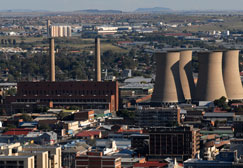South Africa plans for mass urban migration
27 May 2015
South Africa's urban population is growing larger and younger, and it is envisaged
that nearly 80% of the total population will be living in an urban area by 2050.
Co-operative Governance and Traditional Affairs Deputy Minister Andries Nel said
this yesterday in the National Assembly, when he briefed the portfolio committee on
the draft Integrated Urban Development Framework (IUDF).
"South Africa is urbanising rapidly. The United Nations estimates that 71.3% of
South Africa's population will live in urban areas by 2030, nearly 80% by 2050.
South Africa's urban population is growing larger and younger. Two-thirds of South
African youth live in urban areas."
Cities and large towns produced over 80% of the national gross value added and
metros were growing twice as fast as other cities, he explained. Towns had much
higher – about 40% – average incomes compared to the country as a whole, while
employment grew twice as
fast in metros.
"Between 1996 and 2012, metros accounted for 75% of all net jobs created in South
Africa. Despite this, 'urbanisation of poverty' is increasing, especially in townships,
informal settlements and inner cities.
"Urban areas are dynamically linked to rural areas – flows of people, natural and
economic resources. Urban and rural areas are becoming increasingly integrated,
as a result of better transport, communications and migration," Nel explained.
Interdependence of rural and urban spaces needed a comprehensive, integrated
approach to urban development.
High concentrations of people, buildings and infrastructure, he added, increased risk
to natural disasters, climate change and variability. Reducing urban risk was critical
to achieving sustainable urban growth. Safety, particularly in public spaces, was an
essential ingredient for the creation of liveable and prosperous cities.
The deputy minister said urban spaces
needed to be designed and managed in a
way that made citizens feel safe from violence and crime.
"By 2030, South Africa should see reviving rural areas and creating more
integrated, balanced and vibrant urban settlements… To achieve this, the country
must clarify and relentlessly pursue a national vision for spatial development."
Integrated Urban Development Framework
The IUDF seeks to unlock the synergy that comes from co-ordinated investments in
people and places, as well as marking a new deal for South African cities and
towns. It builds on the National Development Plan (NDP) and its vision for urban
South Africa.
"We want cities to be inclusive, resilient and liveable," Nel said. The NDP placed
"transforming human settlements and the national space economy" at its centre.
The IUDF aims to guide development of inclusive, resilient and liveable urban
settlements. It provides a new approach to urban investment by the
developmental
state, guiding the private sector and households.
Its vision speaks of liveable, safe, efficient cities that are socially integrated,
economically inclusive places where residents participate actively in urban life.
Nel said this vision recognised that South Africa had different types of cities and
towns, which had different roles and requirements. The vision must be interpreted
and pursued in differentiated and locally relevant ways.
To achieve the vision, there were four strategic goals:
- Access: to ensure people have access to social and economic services,
opportunities and choices;
- Growth: to harness urban dynamism for inclusive, sustainable economic growth
and development;
- Governance: to enhance the capacity of the state and its citizens to work
together to achieve social integration; and,
- Spatial transformation: to forge new spatial forms in settlement, transport,
social and economic
areas.
Extensive consultations on the IUDF were being undertaken, Nel said, and the final
draft would be completed by November.
Source: SAnews.gov
 A view of Bloemfontein, Free State, from Naval Hill, close to the city centre. (Image: MediaClubSouthAfrica.com, Graeme Williams)
A view of Bloemfontein, Free State, from Naval Hill, close to the city centre. (Image: MediaClubSouthAfrica.com, Graeme Williams)





